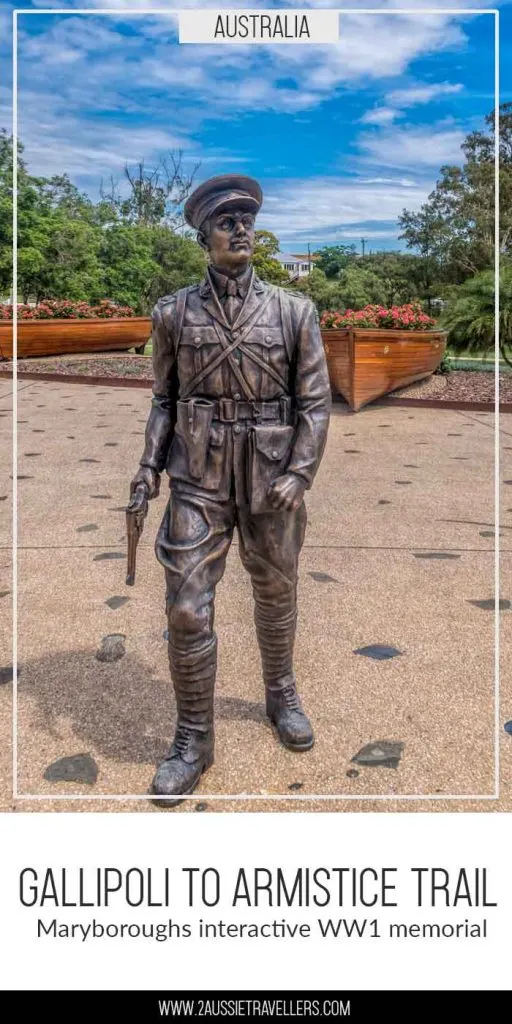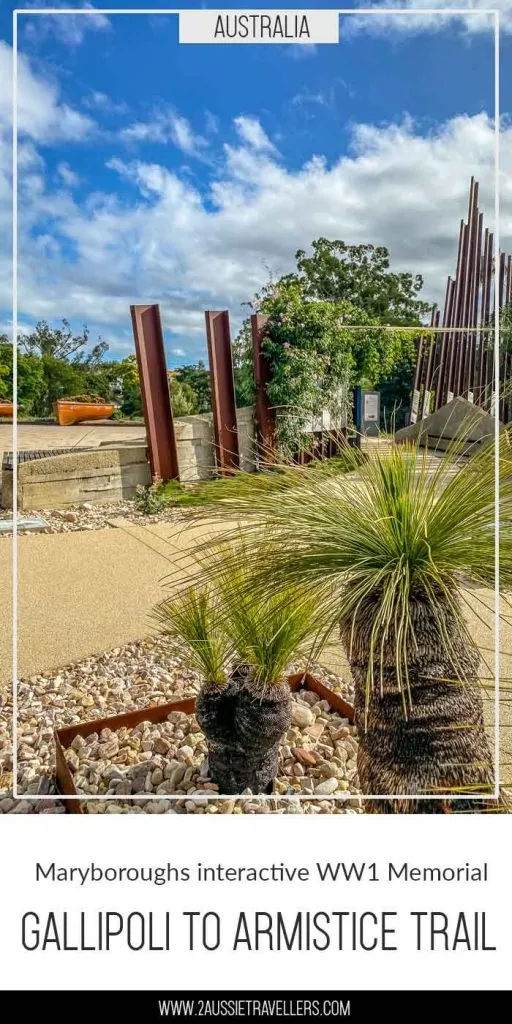The Gallipoli to Armistice trail is an award-winning memorial, located in Maryborough, Queensland. It’s one of the most comprehensive tributes and informative war memorials in Australia.
It all started with a single statue of Duncan Chapman, erected in 2015. Duncan is remembered as the first Allied soldier to step foot on the sand in ANZAC cove at Gallipoli. He was also a young local man whose story could belong to thousands of others.
Duncan lived a few blocks from Queens Park, he went to school here and started work as a clerk at a local law practice before enlisting in Maryborough. Like so many others, he probably anticipated his first trip overseas as an adventure not the horror story it was to be.

This initial statue was erected with funding support from local residents and continued on to inspire the Gallipoli to Armistice trail that opened in July 2018. The end result is one of the country’s top war memorials and one we’d encourage everyone to visit. We’re pleased to see it’s part of the school curriculum with groups from across South East Queensland making the trip up here for the war memorial and World Heritage Listed Fraser Island.
Duncan now stands in the centre of a large open area representing ANZAC Cove. Behind him the wooden prow of three landing boats and footprints representing the thousands who followed in his footsteps in the subsequent days and months. The details and symbolism throughout the exhibit is exceptional and it’s well worth studying it in some detail as you wander through.
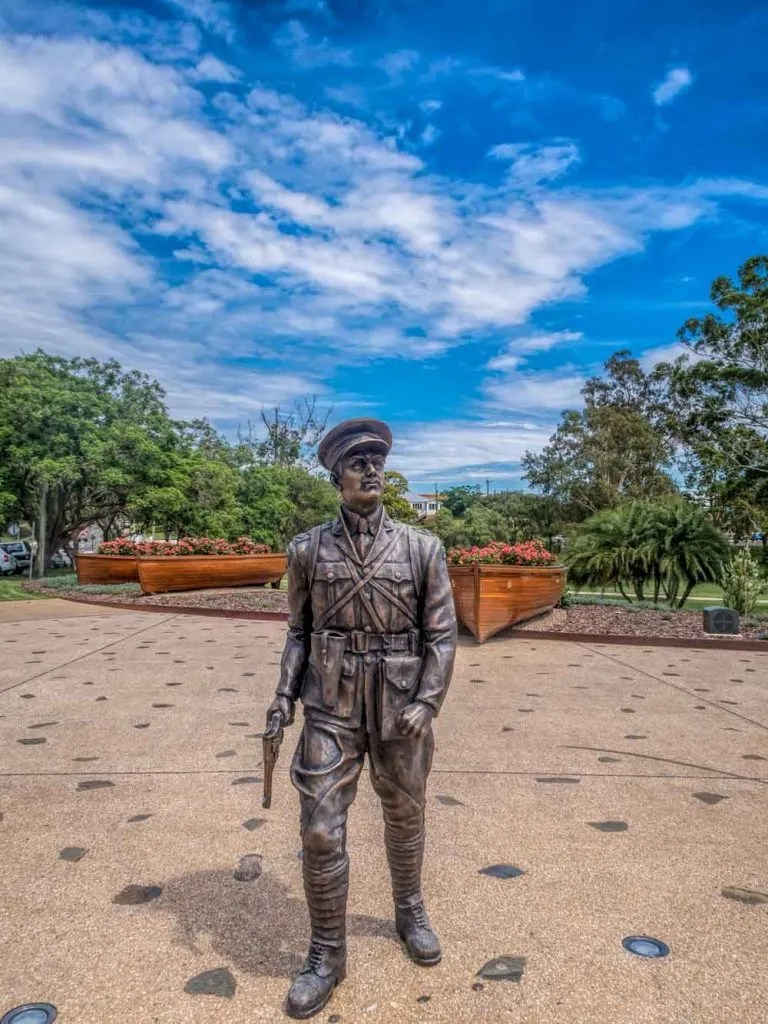
At the foot of the statue, a handful of tiny stones are placed in the concrete and in the towering iron pillars in front that representing the cliffs of Gallipoli is a small inset box that contains soil from those cliffs. Both were gifted by the Queensland Turkish Consul. We understand a further gift, a relief mask of Ataturk is currently being prepared to be added soon.
Take a walk behind the ‘cliffs’ and you will discover storyboards sharing excerpts from the letters home sent by local men and women. During the war official news was scarce and sterilised, families gave letters to the newspapers that were published and these records have provided the basis for much of the detail in the exhibit. You’ll find extracts and stories on the boards, others are told through the motion-activated speakers along the trail and also behind the QR codes along the way. If you have your phone with you these provide far more depth to the story.
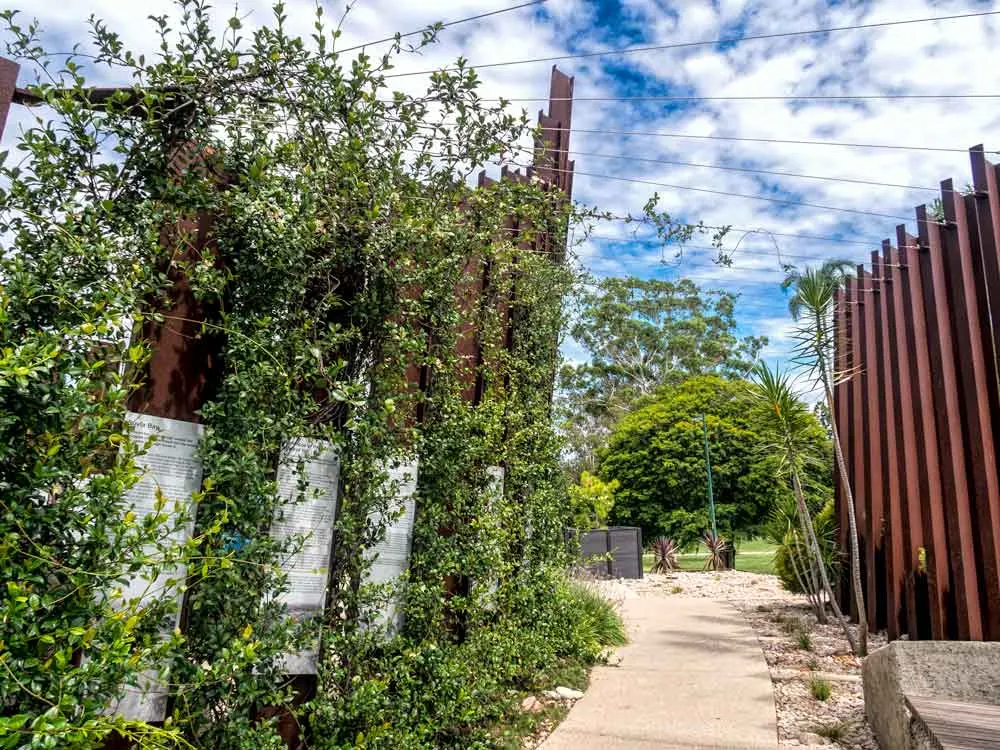
Every detail has a purpose and architect Grant Calder incorporated some that may not immediately be apparant like the cuts marked in the concrete extending out behind the pillars here. From above the lines form the symbol of the rising sun and the spirit of ANZAC.
The timeline is marked out on the pavement as you follow the trail, the motion-triggered boxes along the way adding the sound of marching feet and further commentary. Midway through the trail, you will hear the hymn Aue e Ihu (Jesus, lover of my soul) the hymn sung by the Maori Battalion before their first battle.
Another bronze statue sits on the wall, a woman of indeterminate age, she’s dressed in her town clothes and clutches a letter, no doubt collected from the Post Office just around the corner and torn open and read as soon as she reaches the quiet of the park. She represents those at home, waiting for news from the other side of the world, the nuance in the symbolism here is is subtle, also in brass, her image wears the patina of time but differently, softer, than the soldiers at either end of the trail.
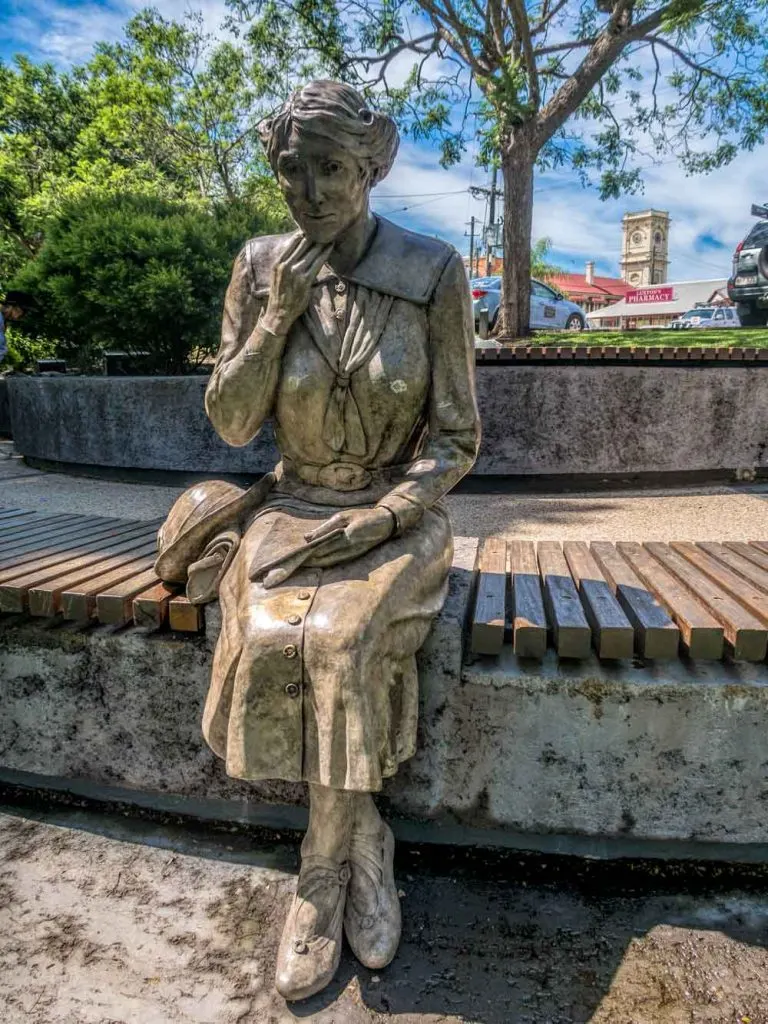
Nearby are a journalists typewriter, glasses and notebook, the sculptor’s skill in these is incredible. Created at a 2x scale it’s a replica of the typewriter used by war correspondent Charles Bean, and working from a photo of one of his journals the sculptor has replicated his handwriting legibly on the page. While many journalists wrote from afar, Charles Bean was on the ground in Gallipoli and Pozieres and it was his conversation with a dying soldier near the front in Pozieres who asked ‘will they remember me in Australia’ that inspired his vision that became the Australian War Memorial in Canberra.
The trail ends with another soldiers statue, this time his uniform worn and dishevelled, a deceased soldiers helmet and gas mask slung over his arm and the haunting stare into the distance that we only now, over 100 years later, begin to recognise as PTSD, the silent and largely unrecognised threat to our servicemen and women.
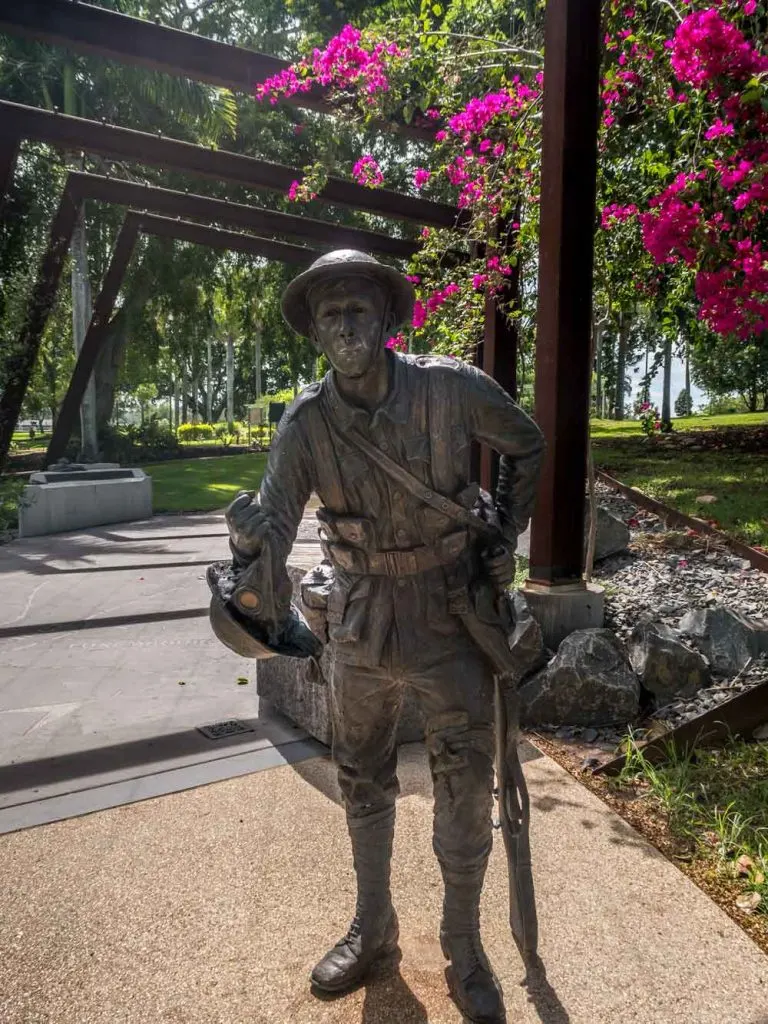
The Maryborough memorial doesn’t pull its punches, the words and emotion are raw and honest. It doesn’t shy away from topics that at times weren’t talked about and in doing so is all the more a tribute to all the men and women who gave so much for our freedom. It’s perhaps a feature of the Maryborough psyche to give recognition where it is due. The Cenotaph that lies beyond the trail was erected back in 1922 and is unique in Australia in recognising equally not only the army, navy and airforce but the nurses too.
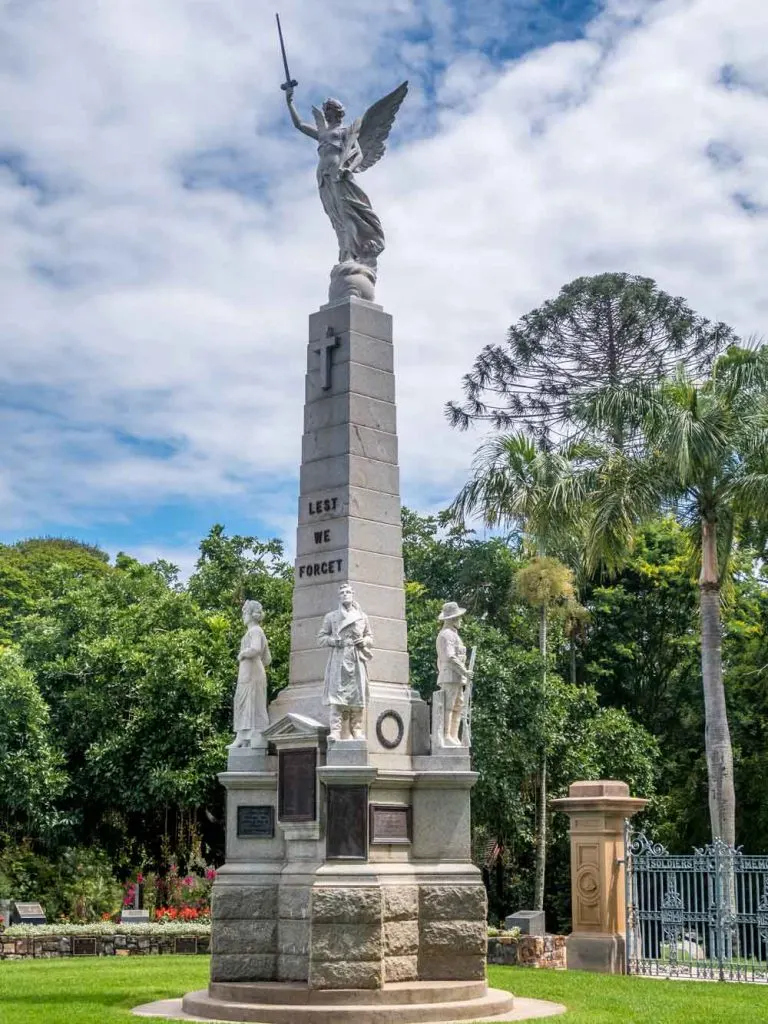
Gallipoli to Armistice Trail Visitor Information
We’ve been through the trail a couple of times now and would highly recommend it as a ‘must see’ for those travelling through the area. If you would visit the National War Memorial when you are in Canberra, then you should experience the Gallipoli to Armistice trail if you are passing through the Fraser Coast. Most recently we were privileged to receive a guided tour from a local who is both a great storyteller and extremely knowledgable on the history and construction of this memorial. Normally his tours are reserved for school groups but you don’t need a guide, the memorial has all the information embedded within it to experience it at your own pace.
Accessibility: The Gallipoli to Armistice Trail is fully accessible to wheelchairs and those with mobility constraints. Wide flat paths wind through the trail and the information boards and exhibits are placed where they can be viewed most easily. QR codes lead to website information that can be read on your own device or interpreted by screen readers. There are also seats in the exhibit to rest if needed.
Cost: The memorial is free to access at any time.
Location: The Gallipoli to Armistice Trail is located on the city side of Queens park along Sussex Street. There is street parking available around the city but if you want longer parking or need to park an RV for the day you’ll likely have success on the far side of Queens Park near the Brolga Theatre. From there it’s a short walk through the heritage listed parklands to town.
Time: How long to stay at the Gallipoli to Armistice trail will depend on your personal level of interest but if you want to read the boards, listen to the interactive recordings and take in the many details we’d suggest allowing at least an hour.
Enjoy your visit: Wear comfortable shoes and a sunhat as it’s an exposed outdoor location. There are 27 storyboards on display so if you wear reading glasses you’ll want those with you too.
